The purpose of this document is to provide the necessary information to check the accuracy of a Professional Medical Thermometer.
This infrared thermometer meets requirements established in ASTM Standard E 1965–98 (for the thermometer system).
Temporal artery thermometry (TAT) is a completely new method of temperature assessment, using infrared technology to detect the heat naturally emitted from the skin surface. In addition, and of key importance, the method incorporates a patented arterial heat balance system to automatically account for the effects of ambient temperature on the skin.
This method of temperature assessment has been shown to improve results and reduce costs by non-invasively measuring body temperature with a degree of clinical accuracy unachievable with any other thermometry method.
Temperatures are more reliable than with other methods. Fevers are identified sooner. Treatment can be initiated sooner. We trust you will find temporal artery thermometry is simply a better method.
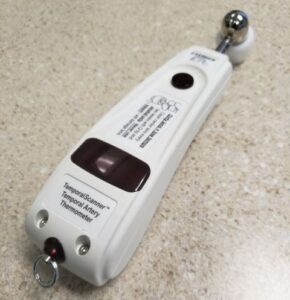
Temporal scan Thermometer
One of the most important features of the medical thermometer is its ability to scan. It is a patented feature of the instrument. Scanning is critical in obtaining the correct temperature since there are temperature gradients present not only inside the body but across the entire surface of the body.
The object of scanning is to capture the highest temperature, the peak, in the area being scanned. As long as the button is depressed, the medical thermometer will be continually sampling and recording the highest temperature it measures.
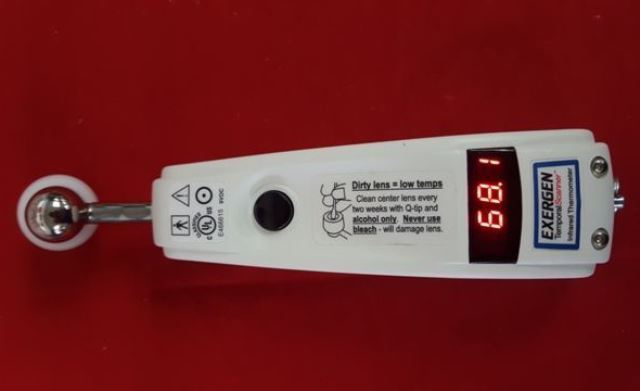
How to use non contact infrared thermometer?
Before Using, Familiarize Yourself with the Instrument:
- To Scan: Depress the red button. The instrument will continually scan for the highest temperature (peak) as long as the button is depressed.
- Clicking: Each fast click indicates a rise to a higher temperature, similar to a radar detector. Slow clicking indicates that the instrument is still scanning, but not finding any higher temperature.
- To Retain or Lock Reading: The reading will remain on the display for 30 seconds after the button is released. If measuring room temperature, the temperature will remain on the display for only 5 seconds.
- To Restart: Depress the button to restart. It is not necessary to wait until the display is clear, the medical thermometer will immediately begin a new scan each time the button is depressed.
- Pulse Timer: The medical thermometer has a built-in pulse timer. To activate, you should touch something >90 o F (32 o C) (skin), press the red button once, and release it. The display will remain on for 30 seconds.
Temperature with a temporal thermometer
Things To Know Before Taking Temperatures
- Measure only the exposed side. Anything covering the area to be measured would insulate it and prevent the heat from dissipating, resulting in falsely high readings. Brush hair aside if covering the temporal artery, or the area behind the ear.
- Slide the thermometer straight across the forehead (midline), and not down the side of the face. Midline over the temporal artery area, the temporal artery is less than 2mm below the skin surface, whereas as the temporal artery winds down the side of the face, it is further from the skin surface. Although anatomically correct, sliding downwards would result in falsely low readings.
- It is preferable to hold the instrument sideways, as illustrated in Figure 2. Approaching your patient with the instrument straight up and down could be somewhat intimidating.
- When making the measurement behind the ear as in Figure 3, tuck the thermometer under the ear lobe in the soft conical depression on the neck just below the mastoid. This is the place where a dab of perfume is typically applied.
- Using on an Infant: An infant is apt to present bundled, with blankets and clothing covering the neck area. Fortunately, the perfusion rate (blood flow) is normally strong for infants, and unless visibly diaphoretic (abnormal sweating), one measurement at the temporal artery is typically all that is required.
Should you feel the temperature is low, then push aside any clothing or blankets covering the neck area for ~30 seconds or so, and repeat the measurement behind the ear.

Medical thermometer forehead
How to use a medical thermometer: Test it first on your hand to get comfortable with the concept.
Depress the red button, and keep it depressed. Scan the probe over the center area of your palm, keeping the probe about half an inch off the surface to avoid cooling the skin.
The display will flash SCAN, and there will be a soft but rapid clicking sound each time the sensor detects a temperature higher than the one before.
When the flashing and clicking slowly to a little less than 1 per second, the peak temperature has been reached. Any of the above indications can be used to assure the peak temperature has been reached.
Remove the instrument from your palm and release the button and note the reading on the display.
The reading will be locked on the display for 30 seconds unless you press the button before that time.
Repeat the above steps and you should get the same, or very close to the same number since your hand will usually not appreciably change temperature very quickly.
Thermometer scanner for adults
How to read a medical thermometer: Practice Holding Your Temporal Scanner.
The Temporal Scanner is ergonomically designed specifically for its application. It’s best to hold the instrument with your thumb on the red button, much like you would hold a remote control.
Along with allowing you to easily read the temperature display, you will automatically be using finger dexterity to gently position the probe, providing comfort and safety for your patient, and consistently accurate temperature readings.
Temporal artery thermometer accuracy
It has been clinically proven in premier university hospitals to be more accurate than ear thermometry, and better tolerated than rectal thermometry. It is a superior method for patients and clinicians alike.
The Temporal Scanner is an infrared thermometer designed for accurate, completely non-invasive temperature assessment by scanning the temporal artery. It is a breakthrough technology.
Temperature is measured by gently stroking the Temporal Scanner across the forehead, and includes a momentary touch of the probe to the neck area behind the ear lobe, to account for any cooling of the forehead as a result of diaphoresis (abnormal sweating).
The patented arterial heat balance technology automatically measures the temperature of the skin surface over the artery and the ambient temperature. It samples these readings some 1000 times a second, ultimately recording the highest temperature measured (peak) during the course of the measurement. The Temporal Scanner emits nothing – it only senses the natural thermal radiation emitted from the skin.
Why measure behind the ear lobe? Sweat causes evaporative cooling of the skin on the forehead and introduces the possibility of falsely low temperatures. Fortunately for the method, during diaphoresis (abnormal sweating), the area on the head behind the ear lobe will always exhibit the high blood flow necessary for the arterial measurement.
Temporal artery temperature
Why the Temporal Artery?
The Temporal Artery method was developed in response to the clinical requirements for a truly non-invasive, accurate method of thermometry.
Oral thermometry is subject to many artifactual errors; rectal temperature meets with strong resistance from patients, parents, and even many clinicians.
Ear thermometers, although convenient, are sensitive to technique. Some brands are known to miss fevers, and it’s difficult to consider the use of an oral thermometer when 95% of pediatric visits concern ear infections.
A site for detecting fevers with roots dating back to centuries before Christ, the temporal artery demonstrated the necessary requirements to meet the stringent demands of clinical medicine today: it is easily accessible, contains no mucous membranes, and notably, maintains a relatively constant perfusion rate, ensuring the stability of blood flow required for the measurement method.
- As a site for temperature measurement, the temporal artery presents many benefits:
- it poses no risk of injury for patient or clinician,
- eliminates any need for disrobing or unbundling, and
- is suitable for all ages.
Original temporal artery thermometer
TAT-5000 Series thermometers are used by medical professionals in clinical environments. Such medical professionals include physicians, nurses, nurses’ aides, patient care technicians, and others who are trained to take the temperature of patients.
Clinical environments include areas where medical professionals are providing medical services for patients, including hospitals, outpatient clinics, primary care offices, and other settings where the temperature is taken as part of patient care.
Clinical environments include Emergency Medical Services environments.
The most read
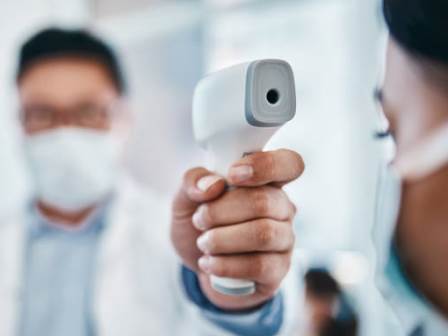
Medical Grade Thermometer
As people plan to get back into a rut, many are considering buying technologies that can detect elevated temperatures.
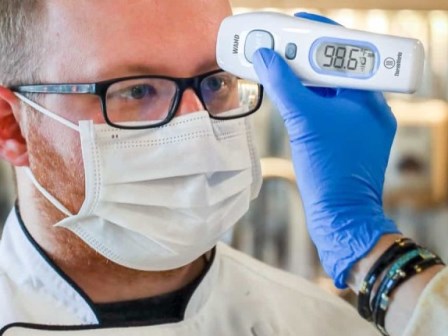
Professional-grade Medical thermometer
Professional diagnostic thermometers are comfortable for the patient and provide accurate readings every time.
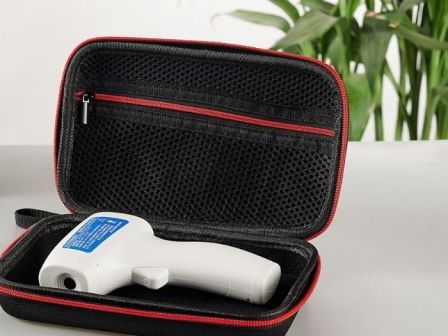
Infrared Thermometer Price
A home use infrared thermometer is a medical device intended for users in any environment outside of a professional healthcare facility.
